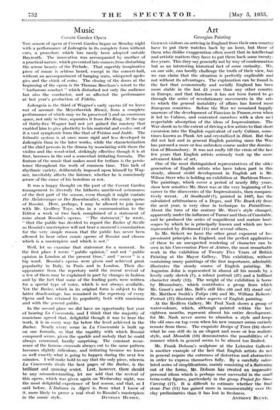Art
Georgian Painting GERMAN visitors on arriving in England from their own country have to put their watches back by an hour, but those of them who dislike exaggeration often assert that in intellectual and artistic matters they have to put them back some twenty- five years. This they say generally not by way of condemnation but as an interesting historical fact of some curiosity. We, on our side, can hardly challenge the truth of their view, but we can claim that the situation is perfectly explicable and not without its advantages. The explanation can be found in the fact that economically and socially England has been more stable in the last 25 years than any other country in Europe, and that therefore it has not been forced to go through the series of revolutionary movements in the arts to which the general instability of affairs has forced most European countries. Before the War we remained happily unaware of the development of Fauvism in France, even when it led to Cubism, and contented ourselves with a slow awl respectable absorption of the ideas of Impressionism. The War shook us to the extent of driving a few artists to that short excursion into the English equivalent of early Cubism, some- times known as Plank Art and crystallized in Blast. But that did not last and in general English painting since the War has pursued a more or less unbroken course under the domina- tion of Bloomsbury. It was not really till the crisis of the last few years that English artists seriously took up the more advanced kinds of art.
One of the most distinguished representatives of the older generation of English artists who have taken part in this steady, almost stolid development in English art is Mr. Wilson Steer who is holding an exhibition at Barbizon House. The paintings, which cover a period of nearly fifty years, show how sensitive Mr. Steer was at the very beginning of his career to the discoveries of the Impressionists, then compara- tively recent. At Southwold (7), painted in 1887, has the calculated arbitrariness of a Degas, and The Beach (8) from the next year, is very close in technique to Pointillismc. About the turn of the century Mr. Steer's style changed, apparently under the influence of Turner and then of Constable, and he produced the series of magnificent and mature land- scapes by which he is principally known and which are here represented by Richmond (11) and several others.
In Mr. Sickert we have the other great exponent of Im- pressionist principles in England, and the perfect application of these to an unexpected rendering of character can be seen in his Conversation Piece at Aintree, the most remarkable work in the exhibition of Twenty Five Years of British Painting at the Mayor Gallery. This exhibition, without containing many paintings of the first importance, admirably illustrates the steady course of English painting. Mr. Augustus John is represented in almost all his moods by a lovely early sketch (7), a robust portrait (37) and a brilliant character study (12). The weight of the exhibition is borne by Bloomsbury, which contributes a group from which Mr. Grant's and Mrs. Bell's still Ides (36 and 35) stand out. Mr. Matthew Smith's Tulips (40) and Mr. William Roberts' Portrait (57) illustrate other aspects of English painting.
At the Redfern Gallery, Mr. Paul Nash shows a group of water-colours, which, although painted within the last eighteen months, represent almost his entire development, for Mr. Nash never seems to abandon a style and keeps the old ones on tap even when his new manner seems entirely remote from them. The exquisite Design of Trees (24) shows what he can still do in an elegant and more or less realistic style, and Monolith (10) demonstrates the possibilities of a manner which in general seems to be almost too limited.
Mr. Frank Dobson's sculpture at the Leicester Galleries is another example of the fact that English artists do not in general require the extremes of distortion and abstraction in order to express themselves fully. By a carefully calcu- lated series of simplifications, mainly consisting of a flattening Out of the forms, Mr. Dobson has created an impressive personal idiom which is perhaps most successful in the small terra-cotta figures, particularly in the group Project for Stone Carving (17). It is difficult to estimate whether the final stone Pax (11) has' gained more in monumentality over the clay prelinlinctries than it has lost in freshness.
ANTHONY BLUNT.














































 Previous page
Previous page